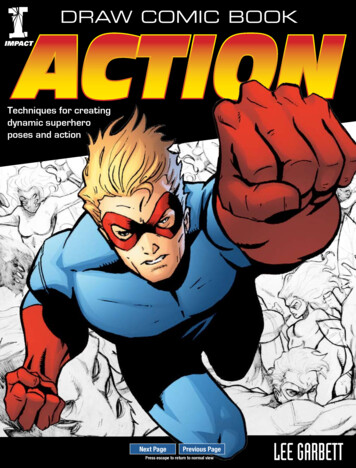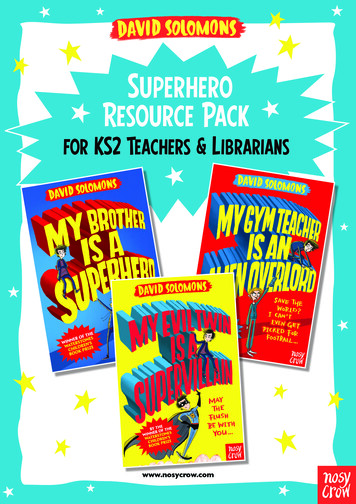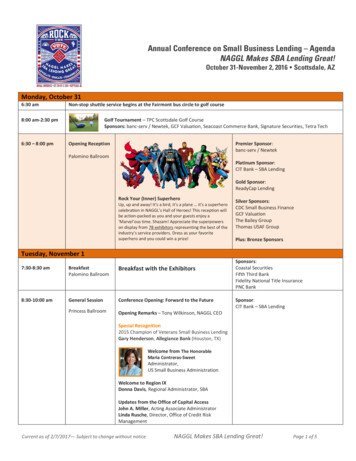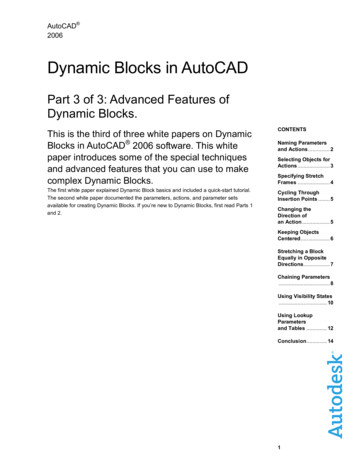
Transcription
Draw Comic BookactionTechniques for creatingdynamic superheroposes and actionNext PagePrevious PagePress escape to return to normal viewLEE GARBETT
‘Basic ToolsFrom your imagination to thumbnails and roughs, through to your finished inked pieceready for that splash of colour, you will need some traditional media and supports. Thevariety available is vast, and you should experiment with different kinds until you find whatworks best for you. Here are the contents of my tool kit for you to use as a guide.RulerVital for ruling up your panels and creating those awesome city scapes.ErasersYou can never have too many of these. Putty and plastic erasers areboth good, and having more than one on the go means that you cangenerally find one that is clean and has a nice edge to work that detail.Mechanical pencilThis pencil is my best friend. I prefer using mechanical pencils totraditional ones, as the fine lines you achieve and the feel of usingthem is much nicer to me. It’s important that you experiment andfind what works best for you, however.Traditional pencilsFrom HB (hard and pale) to 5B (softand dark) there is a wide variety tochoose from. HB can sometimes be abit faint, so I tend to use somewherein between the HB and really darkones, which I find are too heavysometimes. Remember that youultimately need to remove any traceof pencil, so large areas of dark, softgraphite are not very easy to workwith. The softer pencils are goodfor rough work and thumbnails, butI would recommend using hardergraphites in your final work.Black marker penHandy for filling in on inked pieces and picking out thicker lines.Inking pensThey should last you for years, but make sure you have a couple ofdifferent thicknesses to achieve those graphic lines.Brush pensGreat for getting realistic, fluid strokes onto the page either at thelightbox stage or inking. They’re also nice to rough with sometimes.8Basic ToolsNext PageLightboxNot vital for the beginner, but essential for the more experiencedcomic artist. This is an invaluable piece of kit and probably the oneobject I use the most! It is handy for taking rough pieces forwardonto art board, or refining your work onto a clean sheet of paperwithout having to start again. The old fashioned lightboxes usedto be really big, deep and heavy objects, but you can get muchsmaller, thinner and lighter ones now that are portable and morecomfortable to lean on.Previous PagePress escape to return to normal view
Putty eraserStencilsYou don’t need too many ofthese, but I find this circle oneis really useful and speeds upthe drawing process.Good for getting into those tightareas where you need moreprecision than a big old plasticeraser can give you.Masking fluid and inkThe inker’s tools. Cover up areas you don’t wantto be inked with the masking fluid. It’s alwayshandy to have a rag or paper towel close athand when you’re using either of these.Ink thinnerTo add variation in tonewith your inks. Notessential for beginners,but will come in handyif you start to do yourown inks.Correcting fluidEssential for tidying up your inked piece.SupportsThe paper you use to begin your work doesn’t have to be anything special or expensive. Printer cartridge paper at either A4 (US letter) or A3 (UStabloid) size is fine, but when you are moving on to more finished pencils and then to ink, having the sturdiness and extra texture of art boardis vital. You also need this depth for inking as thinner, lighter paper will just absorb too much ink and tear or distort. I draw my final panels ontoart board, and you can buy it online or from a good art store.Next PagePrevious PagePress escape to return to normal viewBasic Tools9
Action: KickingWhere would your superhero be without being able to swing a devastating high kickonto their nemesis? Consider the camera angle of your shot so that you show itfrom the most impactful side: having your character face-on enables you to showthe facial expression which will convey so much of your story; a side profile meansthat you will naturally focus more on the environment, body and clothing, whileit would be very difficult to achieve the desired impact by shooting from behind.Perspective is key in this type of pose where some parts of the body are goingto be closer to the viewer than others, so do lots of research beforehand, armyourself with plenty of references to help you achieve realistic proportion and doplenty of thumbnails and roughs until you’re happy with the way it’s looking.Add in your guides for the facial features.Think about the angle the head is at inorder to create the most dynamic pose;here it is angled down menacingly,revealing all of her head but hiding muchof her chin and one half of her face.Start your image with a simple stick figure.Try to be loose and fluid and in your pencilstrokes to achieve more natural lines.Build up your lines withcylindrical shapes to add form.Keep it simple and clean at thisstage, and remember to eraseany lines you don’t want to keep.150Action: KickingNext PagePrevious PagePress escape to return to normal view2
The hands are a vital part of the storytelling process and cancarry a lot of information about what’s happening in thescene. Try to think about them early in your composition sothat you can show them realistically. Having this hand as aclenched fist adds to the aggression of the shot and helps toset the scene.Pick out your final outline anderase any other unwanted lines.This is going to be the part of the bodythat is closest to the camera, so needs tobe the largest. Foreshortening (see p. 30)can be hard to master, but it will reallyhelp with the storytelling and impact ofyour work.4Tidy up your lines and remove any fromthe final outline that you don’t want. If youare happy with how it’s looking, you canalso start to remove the joint markings.3Next PagePrevious PagePress escape to return to normal viewAction: Kicking51
Once you’ve picked the colours for yourcharacter you need to start putting in thebasic flat areas. This is known as ‘flatting’,and many pro colourists hire someoneto do this bit. It may help to work in thecolours you want to the character to bebut you can use any colours at this stage,as long as you can select each elementseparately to make alterations.10The background (city) and foreground(character) elements should be on aseparate layer so that you can alter themindividually without affecting the other.If you really want to have control youmay want to make several layers for theelements, i.e.: the character’s flesh, hair,costume, gloves etc all on separate layers.11Now you’ve got the colours down and arehappy with the overall look of your imageyou can start adding the form. This stage isknown as ‘Modelling’, as you’re giving thecharacter form and shape. This is the timewhere you’ll want to select a light sourceand start adding shadow and highlights.When that’s done, try adding a colourlayer over all or most of your page; use acolour that you think will give atmosphereto the image – a warm orange or a coolpurple are good starting points. Make thislayer an overlay or multiply it and reduceopacity just so that you get a consistenthue to the image.112Project 1: FlyingNext PagePrevious PagePress escape to return to normal view
Next PagePrevious PagePress escape to return to normal viewProject 1: Flying113
Draw Comic BookactionDescriptionSuperhero feats and exhilarating fights are the climax of a comic book;here readers will learn how to draw this fun and vital part of comic artClever exercises will show how to achieve convincing movement by firstdrawing the torso then building other body components around itTechniques for drawing every dynamic action are explained from running,swinging and flying through to fist fights, group rumbles, and battlesAn Action File of comic character drawings in dynamic poses forms aninvaluable resource; accompanied throughout by the kick-ass images ofcomic artist Lee GarbettMarketing PointsSpecificationsPublication dateNovember 2010Size (HxW):Size (WxH):Extent:lllustrations Colour:Edition:Word Count:276 x 210mm81/4 x 103/4in128pp200First20,000Comic book action is what everyone wants to drawand this is the first book devoted solely to the subject Includes plenty of step-by-step demonstrations plus anAction File of action poses as a quick reference The interest in comics continues at a pace highlightedby numerous movie releases during 2010 and 2011Rights Available: WorldCategory: Art TechniquesBIC Code1: WFA Painting & ArtManualsBIC Code2: AKLC Comic Book &Cartoon ArtISBN:Imprint:RRP:Format:978-1-44030-813-0Impact 14.99PaperbackISBN:Imprint:US RRP:Format:978-1-44030-813-0Impact 19.99PaperbackContents Introduction1 Tools and basic techniques2 The figure3 Basic action4 Fighting5 Action file6 Composition7 Storytelling8 Step projects IndexThe AuthorLee Garbett is one of DC’s hot newartists. He has worked on Midnighter, TheHighwaymen and Dreamwar at Wildstorm,and the Outsiders, Batman Last Ritesand currently Batgirl at DC. In the UKhe started out on 2000 AD; other clientsinclude the BBC, The Face, and AmericanExpress. He lives in Devon, UK.Return To StartPrevious PagePress escape to return to normal view
Action File of action poses as a quick reference The interest in comics continues at a pace highlighted by numerous movie releases during 2010 and 2011 Introduction 1 Tools and basic techniques 2 The figure 3 Basic action 4 Fighting 5 Action file 6 Composition 7 Storytelling 8 Step projects Index










